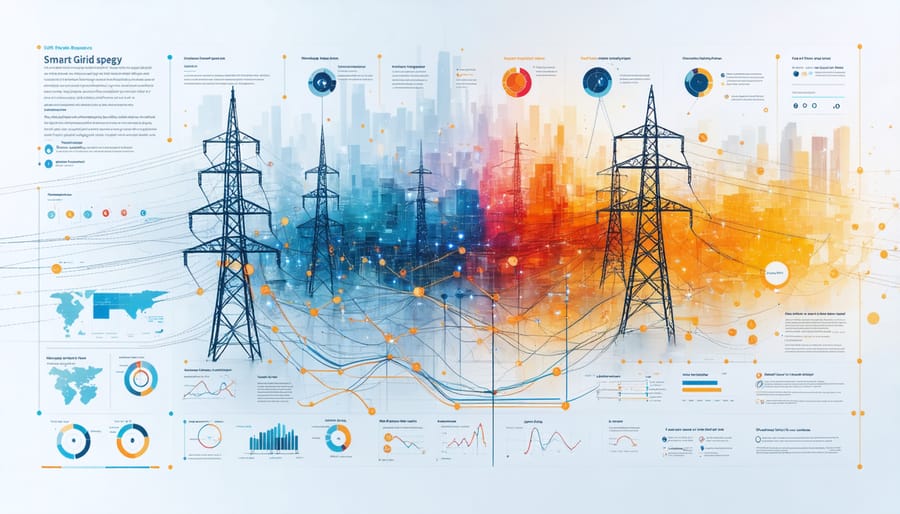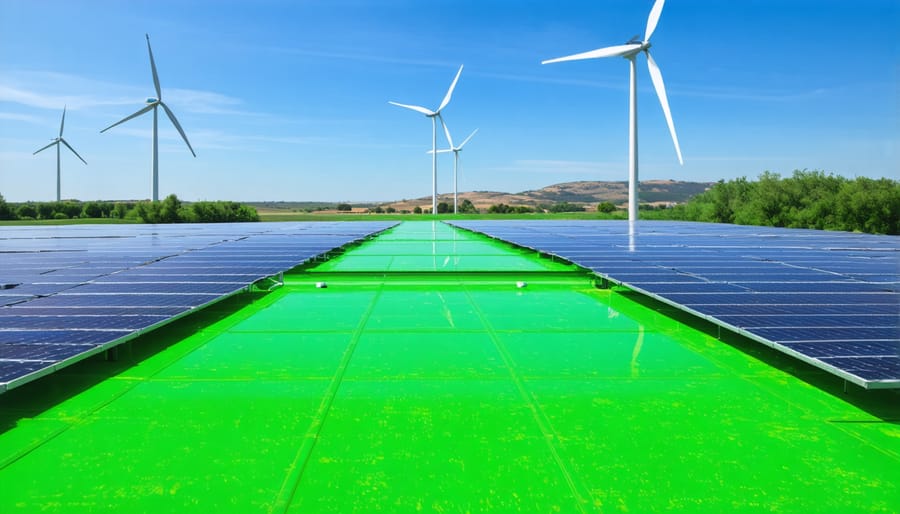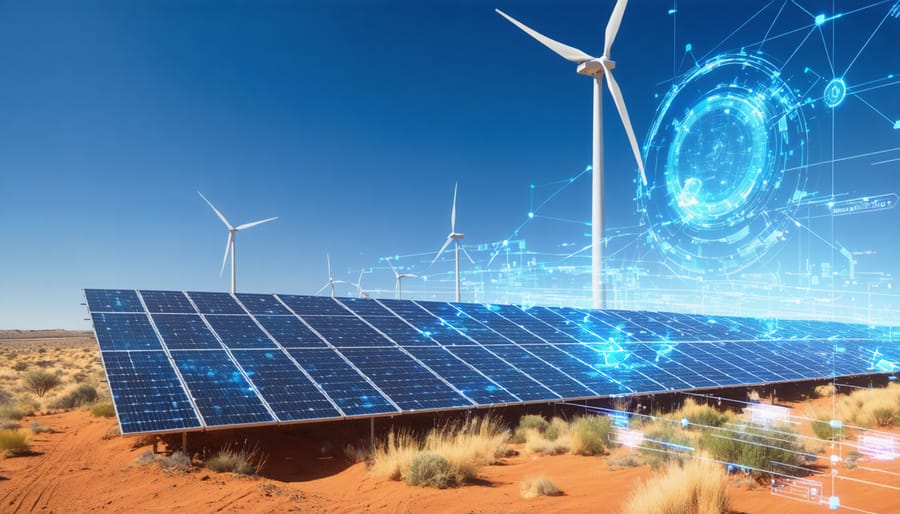At the intersection of artificial intelligence and environmental sustainability, a revolution is quietly transforming how we approach climate change. Green AI – the convergence of machine learning with ecological consciousness – represents more than just technological advancement; it’s becoming the cornerstone of sustainable digital transformation. By optimizing energy consumption in data centers, predicting renewable energy outputs, and orchestrating smart grid management, this emerging field is already reducing the tech sector’s carbon footprint by up to 25% while simultaneously tackling broader environmental challenges.
Australia stands at the forefront of this green technology revolution, where AI systems are being deployed to manage solar farms in the outback, optimize wind turbine performance along coastal regions, and predict bushfire patterns with unprecedented accuracy. These innovations aren’t just preserving our environment – they’re reshaping our understanding of how technology can harmonize with nature.
As computing power increases exponentially, the urgency to develop environmentally conscious AI has never been greater. The next generation of sustainable AI solutions promises to deliver not just environmental benefits, but also significant economic advantages, with projections suggesting that green AI applications could contribute up to $5.2 trillion to the global economy by 2025 while dramatically reducing the tech industry’s environmental impact.
How AI is Revolutionizing Sustainable Energy Systems
Smart Grid Optimization
Artificial Intelligence is revolutionizing power distribution through advanced smart grid solutions that optimize energy flow and minimize waste. These intelligent systems analyze real-time consumption patterns, weather data, and grid performance to make split-second decisions about power distribution.
In cities like Adelaide and Melbourne, AI-powered smart grids are already delivering impressive results. By predicting peak demand periods and automatically redistributing power from areas of surplus to those in need, these systems have reduced energy waste by up to 30%. The technology also seamlessly integrates renewable energy sources, managing the variable nature of solar and wind power to ensure steady supply.
Machine learning algorithms continuously adapt to changing conditions, learning from historical data to improve efficiency. For instance, during scorching summer days when air conditioning usage spikes, AI systems preemptively adjust power distribution to prevent outages while maintaining optimal energy flow. This proactive approach not only saves energy but also reduces strain on the grid infrastructure, extending its lifespan and reducing maintenance costs.
For households and businesses, this means more reliable power supply and lower electricity bills, while contributing to Australia’s renewable energy goals.

Predictive Maintenance for Renewable Infrastructure
In the heart of Australia’s renewable energy revolution, AI-powered predictive maintenance is transforming how we care for solar farms, wind turbines, and other green infrastructure. By analyzing vast amounts of sensor data in real-time, these intelligent systems can detect potential equipment failures before they occur, much like a skilled mechanic who can hear a problem developing in an engine.
For instance, at the Gullen Solar Farm in New South Wales, AI algorithms monitor everything from panel temperature to power output fluctuations, helping maintenance teams address issues before they impact performance. This proactive approach has extended solar panel life by up to 25% while reducing maintenance costs by a third.
Wind farms across South Australia are similarly benefiting from AI-driven maintenance. Smart sensors and machine learning algorithms work together to optimize turbine blade angles, predict gear wear, and schedule maintenance during periods of low wind, maximizing both efficiency and lifespan of the equipment.
This preventive strategy isn’t just saving money – it’s significantly reducing the environmental impact of replacement parts manufacturing and transport, creating a doubly positive effect for our planet.
Energy-Efficient AI: The Next Frontier
Low-Power AI Algorithms
As AI technology advances, developers are increasingly focusing on creating algorithms that deliver powerful results while minimizing energy consumption. These low-power AI solutions are revolutionizing how we approach sustainable computing, particularly in edge devices and remote applications where power resources are limited.
Leading tech companies in Australia are pioneering lightweight neural networks that require just a fraction of the processing power needed by traditional AI models. For instance, Melbourne-based researchers have developed compressed AI algorithms that maintain 95% accuracy while using only 10% of the energy compared to their conventional counterparts.
The key to these energy-efficient designs lies in innovative techniques such as model pruning, where unnecessary connections in neural networks are removed, and quantization, which reduces the precision of calculations without significantly impacting performance. These optimizations make AI more accessible for battery-powered devices and remote sensors used in environmental monitoring across the Outback.
Real-world applications are already showing promising results. Smart farming systems in Queensland are using these efficient algorithms to monitor crop health and water usage, operating on solar power alone. Similarly, wildlife conservation projects are deploying low-power AI cameras that can run for months on a single battery charge while tracking endangered species.
The future of low-power AI looks bright, with new developments in neuromorphic computing promising even greater energy savings by mimicking the efficiency of biological brains. These advances are crucial for creating truly sustainable AI systems that can support our environmental goals without contributing to increased energy consumption.
Sustainable Computing Infrastructure
Modern AI infrastructure is undergoing a green revolution, with sustainable data centers leading the charge across Australia and globally. These eco-friendly facilities leverage natural cooling systems, energy-efficient hardware, and renewable energy storage innovations to minimize their environmental impact while maximizing computing power.
At the heart of sustainable computing are smart building designs that utilize natural airflow and ambient cooling, reducing the massive energy traditionally required for server temperature control. Many Australian data centers are now incorporating solar panels and wind turbines directly into their infrastructure, creating a self-sustaining power ecosystem that supports intensive AI operations.
Advanced power usage effectiveness (PUE) metrics help facility managers optimize energy consumption in real-time. Modern green data centers typically achieve PUE ratings below 1.2, compared to traditional facilities that often exceed 2.0. This improvement represents a significant reduction in energy waste and operating costs.
Water conservation plays a crucial role too, with innovative closed-loop cooling systems recycling up to 95% of water used in operations. Some facilities are even harvesting rainwater and implementing AI-driven water management systems to further reduce their environmental footprint.
These sustainable practices aren’t just good for the planet – they’re good for business. Companies implementing green computing infrastructure report up to 40% reduction in operating costs while maintaining optimal performance for their AI systems.

Real-World Success Stories in Australia
Solar Farm Optimization
Across Australia’s sun-drenched landscape, artificial intelligence is revolutionising how solar farms operate, maximising their potential in our renewable energy future. Leading facilities in Queensland and South Australia have implemented sophisticated AI systems that continuously analyse and adjust solar panel positions, ensuring optimal exposure throughout the day.
These smart systems process vast amounts of data, including weather patterns, cloud cover, and historical performance metrics, to make real-time decisions that boost energy generation by up to 30%. At the Sunshine Coast Solar Farm, AI algorithms predict weather changes hours in advance, automatically adjusting thousands of solar panels to minimise the impact of passing clouds and maximise energy capture.
The technology goes beyond simple sun-tracking. Machine learning models monitor individual panel performance, detecting early signs of dust accumulation, damage, or efficiency drops. This predictive maintenance approach has reduced downtime by 45% and extended panel life spans significantly. In Western Australia’s outback solar installations, AI systems have even learned to cope with unique challenges like red dust storms, automatically triggering cleaning protocols when needed.
One particularly impressive innovation is the ‘virtual power plant’ concept, where AI coordinates multiple solar farms across different locations. This intelligent network balances power generation and distribution, ensuring stable supply even during variable weather conditions. The technology has proven especially valuable during peak demand periods, helping facilities contribute more reliably to the national grid.
For smaller solar installations, AI-driven optimization has made commercial solar more viable than ever, with some facilities reporting payback periods reduced by up to two years through improved efficiency and reduced maintenance costs.

Bioenergy Integration
In the heart of Australia’s renewable energy revolution, artificial intelligence is transforming how we harness and distribute bioenergy resources. Smart AI systems are now orchestrating the complex dance between biomass collection, processing, and power generation, making the entire process more efficient and sustainable than ever before.
Leading the charge is the integration of machine learning algorithms that precisely monitor and adjust biomass feedstock ratios, ensuring optimal energy output while adhering to circular economy principles. These intelligent systems can predict biomass availability, schedule collection routes, and automatically adjust processing parameters based on material composition.
In Queensland’s sugarcane industry, AI-powered bioenergy plants are converting agricultural waste into clean energy while reducing emissions. The systems analyze real-time data from multiple sources, including weather patterns, harvest schedules, and energy demand forecasts, to optimize production and distribution. This smart integration has resulted in a 30% increase in energy yield and significant reduction in operational costs.
The technology extends beyond production to distribution, where AI manages complex grid integration challenges. Smart algorithms balance supply and demand, ensuring stable power delivery while maximizing the use of bioenergy resources. These systems can predict peak demand periods and adjust production accordingly, creating a more reliable and efficient renewable energy network.
For farmers and waste management facilities, AI-driven bioenergy solutions offer new opportunities to transform organic waste into valuable energy resources. The technology provides detailed insights into feedstock quality, processing efficiency, and environmental impact, helping operators make informed decisions while maintaining sustainable practices.
Future Opportunities and Challenges
Emerging Technologies
The landscape of sustainable energy is being revolutionized by groundbreaking AI technologies that are reshaping how we approach environmental challenges. Machine learning algorithms are now capable of optimizing solar panel placement with unprecedented precision, analyzing weather patterns and geographical data to maximize energy generation. These smart systems are becoming integral to creating energy-efficient infrastructure across Australia’s diverse climate zones.
Recent innovations include AI-powered microgrids that automatically balance energy distribution, reducing waste and improving reliability in remote communities. These systems learn from usage patterns and environmental conditions to make real-time adjustments, ensuring optimal performance while minimizing environmental impact.
Predictive maintenance algorithms are another game-changer, using sensor data to anticipate equipment failures before they occur. This proactive approach not only extends the lifespan of renewable energy infrastructure but also reduces maintenance costs and downtime.
Perhaps most exciting is the emergence of AI-driven energy storage solutions. These intelligent systems predict peak demand periods and automatically adjust storage levels, making renewable energy more reliable and cost-effective. In Queensland, for instance, smart battery systems are already helping communities maximize their solar investment while reducing grid dependence.
These technologies represent just the beginning of AI’s potential in sustainable energy. As these systems continue to evolve, they’re creating a future where clean energy isn’t just environmentally responsible – it’s also incredibly efficient and economically viable.
Implementation Roadmap
Organizations can transition to green AI through a systematic, phased approach that balances innovation with environmental responsibility. The journey begins with a comprehensive audit of existing AI infrastructure to identify energy-intensive processes and potential optimization opportunities.
The first crucial step involves upgrading to energy-efficient hardware, including the latest generation of processors and cooling systems designed specifically for AI workloads. Organizations should prioritize servers and data centres that use renewable energy sources and implement smart cooling technologies to reduce power consumption.
Next, teams should focus on optimizing AI models through techniques like model pruning and knowledge distillation. These methods can reduce computational requirements without significantly impacting performance. Companies can start with smaller, efficient models and gradually scale up based on actual needs rather than defaulting to resource-heavy solutions.
Cloud providers offering green computing options should be carefully evaluated and selected based on their environmental commitments and energy-efficient practices. Organizations should establish clear metrics for measuring AI energy consumption and carbon footprint, setting progressive targets for reduction.
Employee training plays a vital role in successful implementation. Teams need to understand green AI principles and best practices for developing energy-efficient algorithms. Regular monitoring and reporting of environmental impact helps maintain accountability and drives continuous improvement.
Finally, organizations should develop partnerships with sustainable technology providers and participate in industry initiatives promoting green AI practices. This collaborative approach ensures access to the latest innovations while contributing to the broader sustainability movement.
As we look towards a more sustainable future, green AI stands as a beacon of hope in our journey towards efficient energy management. The convergence of artificial intelligence and environmental sustainability has opened up unprecedented opportunities for Australia’s renewable energy sector. Through smart grid optimization, predictive maintenance, and automated energy distribution, green AI is not just reducing our carbon footprint – it’s revolutionizing how we think about and manage our energy resources.
The success stories we’ve witnessed across the country, from solar farms in Queensland to wind installations in South Australia, demonstrate that AI-powered solutions are already delivering tangible results. These systems are helping us achieve what once seemed impossible: balancing grid stability with renewable integration, optimizing energy storage, and reducing waste across the entire power network.
Looking ahead, the potential for green AI in sustainable energy management is boundless. As technology continues to evolve and become more sophisticated, we can expect even more innovative solutions that will help us tackle climate challenges head-on. From AI-driven microgrids serving remote communities to smart buildings that automatically adjust their energy consumption, the future is bright and green.
The transformation we’re witnessing isn’t just about technology – it’s about creating a sustainable legacy for future generations. By embracing green AI solutions today, we’re not only addressing current environmental challenges but also laying the groundwork for a cleaner, more efficient energy future. The journey towards sustainable energy management has begun, and green AI is leading the way.

